Japan's Official Development Assistance White Paper 2005
Main Text > Part I JAPAN'S EFFORTS TOWARD ACHIEVING THE MILLENNIUM DEVELOPMENT GOALS (MDGs) > Chapter 2 Specific Measures by Japan toward Achieving the MDGs > Section 2. Poverty Reduction through Economic Growth - the View from Asia's Experience
Section 2. Poverty Reduction through Economic Growth - the View from Asia's Experience
The primary goal of the MDGs is "the eradication of extreme poverty and hunger." Japan believes that increasing the income of the people of developing countries, especially the poor, through economic growth is crucial for achieving this foremost objective of the MDGs.
As discussed in Section 1, achieving economic growth requires improving the investment environment, which involves policy and institution building, human resources development, strengthening basic infrastructure, attracting foreign direct investment, and expanding trade.
Japan has long insisted that economic growth through infrastructure development, etc., is crucial to poverty reduction, and has incorporated this viewpoint in its ODA policies. East Asia provides a good example of where developing countries have forged a path toward achieving the MDGs, ODA has contributed to building the foundation for economic growth, and as a result, poverty has been declining. Japan's support through ODA has made a significant contribution to the economic development of East Asian countries, in the sense that it helped them build the economic infrastructure that underpins growth when they were disadvantaged by underdeveloped international financial markets or limited access to international financial markets. Direct investment from Japan's private sector and the resulting increase in exports and formation of markets, coupled with human resources development through ODA, spurred the East Asian economy to high growth. This expansion of private sector economic activity contributed to the improvement of the income of the poor through increased employment. On the basis of tax income from companies and citizens, the countries of East Asia expanded the delivery of public services, such as health care and education, leading to poverty reduction through human resources development.
Chart 7. Trends in East Asia's Trade Volume, Trade Volume Ratio to GDP, and Amount of Direct Investment Received

To transmit its experiences with East Asian development to the world, Japan has been advocating IDEA (Initiative for Development in East Asia). *1 The key factors in assisting East Asian development as identified at IDEA ministerial meetings and symposiums include the following: (1) ownership (self-help efforts), (2) government's leading role in development, (3) attracting private sector investment, and (4) infrastructure development, policy and institution building, and human resources development. In particular, the development of infrastructure, including that established by ODA, was singled out as the most important role of government in the country's economic development. These IDEA meetings also pointed out that along with the traditional "hard" infrastructure as represented by roads, bridges, electric power stations and irrigation, strengthening "soft" infrastructure such as telecommunications, marketing networks, and technical support was also important.
The successful development experience in Asia was also mentioned in an official document entitled "Africa," which was adopted at the G8 Gleneagles Summit held in July 2005, and it is widely acknowledged that the Asian development experience has been beneficial to development in other regions.
The MDGs set objectives for each sector such as education and health care. However, other factors such as infrastructure development for economic growth, which are not included in the MDGs, are extremely important factors to achieve each of the targets of the MDGs.
Infrastructure development is an extremely effective means for promoting investment from the private sector. Improvement of investment efficiency translates into profits in terms of private companies' business expansion. Private companies enter the markets of regions where infrastructure has already been established, because transportation networks like roads, railways, harbors and airports, and stable access to electric power, telecommunications, gas and water supply, etc., have a direct impact on the earnings of private companies. This inflow of funds through the entry of private companies is an important factor in economic growth.
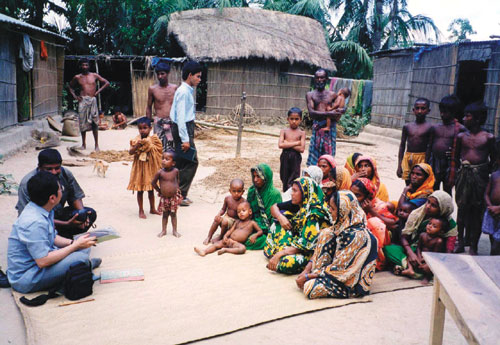
Greater Faridpur Rural Infrastructure Development Project (Bangladesh); Financial provision for civil engineering work and procurement of equipment which was required for the project (Photo: JBIC)
In addition, through the delivery of such infrastructure services as water, electric power, and transportation, infrastructure improves the quality of residents' livelihood. The majority of the poor in developing countries have limited access to safe drinking water, electricity, and roads. These deficiencies are one side of poverty and alleviating them is an objective incorporated in the MDGs. The construction of a single bridge, for example, can facilitate access to medical institutions and enable children to attend school.
Constructing, maintaining, and managing economic infrastructure requires huge expenses to cover these costs for realization of profits. For a private company, performing the construction, recovering costs are usually difficult, and there are sometimes enormous risks involved in project implementation. For this reason, when investment by private companies cannot be expected, ODA is still needed to support infrastructure development.
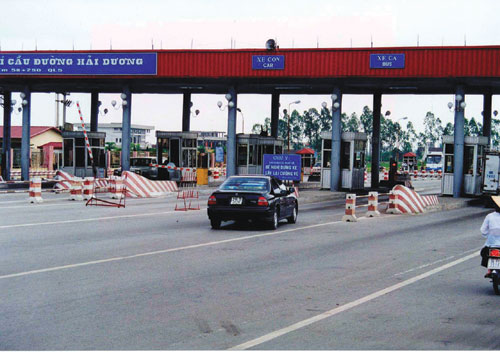
National Highway No. 5 Improvement Project (Viet Nam) (Photo: JBIC)
Nevertheless, in the 1990s, infrastructure development led by the private sector was under way in various countries in Asia and Latin America, leading to a steady decline in the amount of ODA provided for infrastructure development. Since the economic and currency crisis occurred in Asia in 1997, however, private sector-led infrastructure development declined from the end of the decade, and consequently, these were insufficient funds available to developing countries for infrastructure development. For example, in Latin America, infrastructure development by the private sector, after peaking at approximately ¥70 billion in 1998, declined dramatically to approximately ¥20 billion in 2002. 4
According to a joint study by the Japan Bank for International Cooperation ( JBIC ), the World Bank, and the Asian Development Bank ( ADB ), the need for infrastructure development in the East Asian region remains high, and during the five-year period from 2006 to 2010, an annual fund outlay exceeding US$200 billion will be required for construction and maintenance of such infrastructures as roads, water supply, telecommunications, and electric power. 5
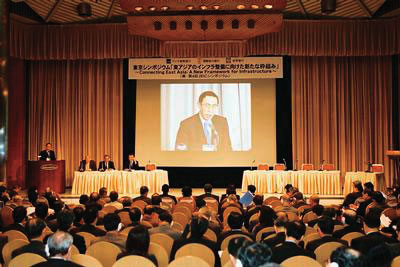
Seminar for Publication of Joint Study by JBIC, World Bank, and ADB (Photo: JBIC)
According to the "Our Common Interest: Report of the Commission for Africa," *1 Africa needs an additional US$20 billion a year investment in infrastructure. To support this, developed countries should provide an extra US$10 billion a year up to 2010 and, subject to review, a further increase to US$20 billion a year in the following five years.
In response to this situation, there has been a worldwide trend to reassess the role of development assistance in regards to infrastructure in recent years. For example, at the World Bank/IMF (International Monetary Fund) Joint Development Committee held in September 2003, the World Bank announced Infrastructure Action Plan that seeks, in light of the importance of infrastructure development, to significantly strengthen support in the infrastructure sector in the future. Meanwhile, "Millennium Project Report; Investing in Development" stated the importance of infrastructure development to achieve the MDGs and indicated that in particular small-scale infrastructure development in rural areas should be promoted. Furthermore, Progress Report by the G8 Africa Personal Representative on Implementation of the Africa Action Plan adopted at the G8 Gleneagles Summit held in July 2005 affirmed that underdevel oped infrastructure is the principle impediment to investment, economic growth and trade, so substantial increase in infrastructure investment is needed to remove this impediment.
The following presents the example of Thailand, where large-scale infrastructure development by Japan's ODA promoted the inflow of private sector funds and contributed to economic growth.
At present, Thailand is undergoing major changes in a variety of socio-economic fields. Thailand's poverty rate declined from 27.2 percent in 1990 to 9.8 percent in 2002, 6 and high economic growth has been maintained, with the growth rate ranging from 5.3 percent in 2002, to 6.9 percent in 2003, and to 6.1 percent in 2004. 7 In the near future, Thailand is likely to join the lower middle income countries.
Japan's ODA has made an important contribution to the economic development and poverty reduction in Thailand through infrastructure development, policy and institution building, and human resources development. Assistance by Japan to Thailand began in 1968, and Japan has been one of the largest donors to Thailand. 8
Box 1. Outline of Discussions and Research Concerning Infrastructure
Support to the Eastern Seaboard Development Program ( ESDP )
Japan actively provided assistance for the development of the Eastern seaboard region, which has now become the second largest economic zone next to the Bangkok metropolitan area. Between the 1980s and the first half of the 1990s, development of this area was positioned as Thailand's highest priority. In this connection, Japan supported the development project known as the Eastern Seaboard Development Program, 9 providing assistance for 16 infrastructure projects totaling approximately ¥180 billion in yen loans. 10 Particularly the following two undertakings were core projects: (1) construction of an industrial park and industrial port in the Map Ta Phut district aimed at promoting the development of heavy and chemical industries, (2) construction of Leam Chabang Port 11 and an industrial estate in the Leam Chabang district. Other projects are water resource development and water conveyance projects to meet the demand for industrial use, and development of railway and expressway networks to meet transportation needs in these districts.
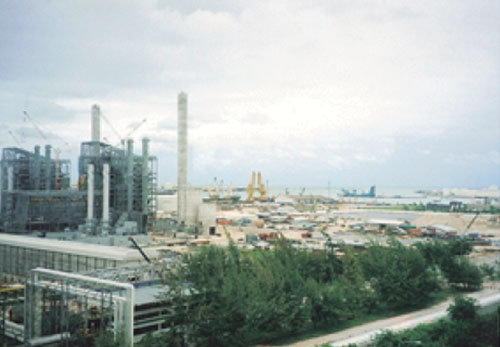
Map Ta Phut Port Today (Photo: JBIC)
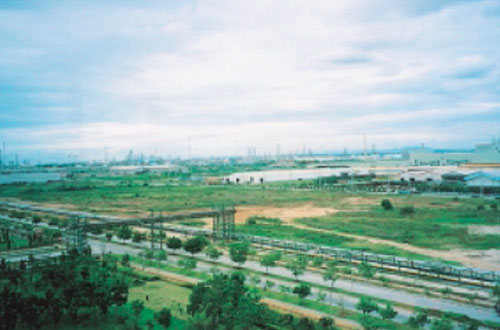
Map Ta Phut Industrial Complex (Photo: JBIC)
Chart 8. Trends in GDP Per Capita in Thailand

Box 2. Eastern Seaboard Development Plan (ESDP)
Dr. Pishit Pakkasem, who served for about 10 years as director of the Eastern Seaboard Development Committee established in 1981 and later as Director-General of the National Economic and Social Development Board ( NESDB ), has expressed his view that Japan's contribution to the Eastern Seaboard Development Program was extremely significant. 12

"Mr. Pishit being interviewed, talking about the Eastern Seaboard Developing Plan."
The Leam Chabang Industrial Estate constructed with Japan's ODA is where Thailand's automobile industry is most heavily concentrated, with many automakers' and parts manufacturers' operations set up in the area. At present, the automobile industry is the principal engine for growth in Thailand's economy. In addition, the Leam Chabang Port, which was also constructed through Japan's ODA, has been expanded to become Thailand's largest port and nowadays plays a large part in increasing trade in Thailand. This port boasts the world's 19th largest cargo handling/forwarding volume, surpassing Japan's Tokyo Port (as of 2004).
Thailand's Eastern Seaboard Development Program is an example of infrastructure development realized through Japan's ODA. As such, it has enabled sustainable economic growth by establishing a good investment climate and stimulating private sector activities in Thailand, and thus has contributed to poverty reduction.
Workers at Leam Chabang plant
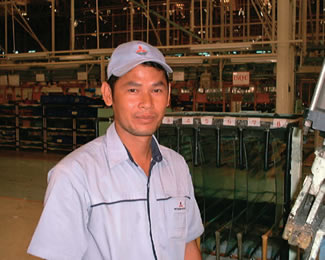
"Laem Chabang offers the best opportunity for career development"

"Companies in Laem Chabang offer extensive welfare programs and good wages. I would like to work here as long as possible"

"Laem Chabang is an optimal work environment for dual income family with children"
Promotion of Agriculture through Small-Scale Irrigation Projects, etc.
Japan's support for small-scale infrastructure development in the agriculture sector, provided in combination with technical cooperation, is parallel to its support for large-scale infrastructure development in Thailand which has been described in the examples above. Through this support, Japan has contributed to regional agricultural development and poverty reduction.
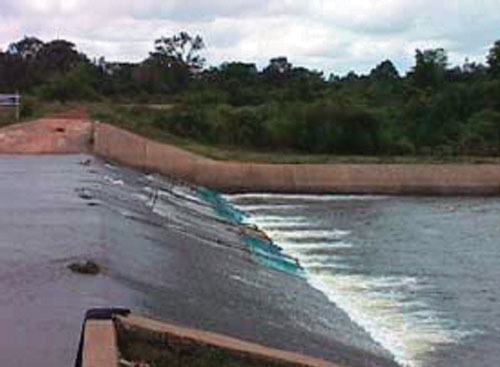
Ban Yang Kut Reservoir Constructed with Small-Scale Irrigation Projects (Photo: JBIC)
Although Thailand experienced rapid industrialization in the beginning of the 1980s, agriculture was still the foundation of Thailand's economy, with about 60 percent of its population engaged in agriculture. Agriculture was particularly concentrated in the northeast region of the country, and despite accounting for about one-third of Thailand's land area and population, the region's per capita GRP (Gross Regional Product) was low, with a high poverty rate.
These conditions prompted Japan's assistance to improve the living standards of the poor through support of agricultural development. From 1978 to 1985, Japan provided support for the construction of small-scale water facilities (reservoirs, dams, water volume regulating facilities, etc.) at 4,000 locations in the northeast and northern farming districts of Thailand. These supports increased rice harvests thanks to stable supply of irrigation water, which in turn enabled crop growing during dry periods, and thus increased employment during farmers' busy seasons. These results contributed to the increase of income of people in districts of high poverty incidence.
Along with assistance for the construction of irrigation facilities and others described above, various types of support used in combination, such as advisory assistance concerning agricultural finance, farm management, and development of distribution infrastructure were highly effective for promoting agriculture, the key to increasing income among the poor in agricultural districts. Japan extended support in order to raise agricultural productivity based on the self-help efforts of farmers by providing Two-Step Loans13 through the Bank for Agriculture and Agricultural Cooperatives ( BAAC ), 14 a public financial institution in Thailand, for supporting farm land development, the purchase of farm machinery, and farming expenses in the northeast districts. When providing loans, BAAC offers advisory assistance on farm management and provides detailed services to each farm family. As a result of these activities, the efforts of farmers contributed to a shift to highly productive farming whereby crops could be planted during dry periods by using irrigation water and crop transport equipment. In addition, loan repayment to BAAC progressed.
Japan also provided support for road development which would secure access to markets for surplus crops, and for electric power supply, thereby helping to improve living standards of people in the northeast region.
Furthermore, Japan assisted in developing home-based industries, particularly sewing work using sewing machines purchased through yen loans, which increased employment opportunities for women. In addition to the series of projects implemented through such fund assistance, Japan worked to further enhance the benefits of infrastructure development by dispatching experts on government-related financial institutions concerned with agriculture in order to provide training in methods for appraising agricultural finance, experts on propagating wide spread use of high-grade seeds, and experts on maintaining regional power distribution networks.
Based on a questionnaire survey conducted by the Thai government, regarding farmers nationwide, it was reported that farmers' income had indeed increased.


 Next Page
Next Page